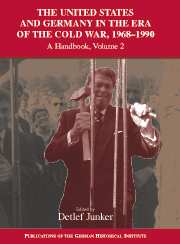Book contents
- Frontmatter
- POLITICS: Détente and Multipolarity: The Cold War and German-American Relations, 1968-1990
- 1 The United States and the German Question
- 2 The Federal Republic of Germany Between the American and Russian Superpowers - “Old Friend” and “New Partner”
- 3 Ostpolitik: Détente German-Style and Adapting to America
- 4 Creative Tension: The United States and the Federal Republic in the CSCE
- 5 The United States, Germany, and the Multilateralization of International Relations
- 6 Expectations of Dominance and Partnership Rhetoric: The Federal Republic of Germany in the Crossfire of American and French Policy, 1945-1990
- 7 West Germany and European Unity in U.S. Foreign Policy
- 8 Cooperation and Conflict in German and American Policies toward Regions Outside Europe
- 9 Two States, One Nation: The International Legal Basis of German-American Relations from Ostpolitik to Unification
- 10 The U.S. Congress and German-American Relations
- 11 The German Political Parties and the USA
- 12 The Role of East Germany in American Policy
- 13 The United States and German Unification
- SECURITY: German-American Security Relations, 1968-1990
- ECONOMICS: Cooperation, Competition, and Conflict: Economic Relations Between the United States and Germany, 1968-1990
- CULTURE: Culture as an Arena of Transatlantic Conflict
- SOCIETY: German-American Societal Relations in Three Dimensions, 1968-1990
- 1 “1968”: A Transatlantic Event and Its Consequences
- OUTLOOK: America, Germany, and the Atlantic Community After the Cold War
- Index
9 - Two States, One Nation: The International Legal Basis of German-American Relations from Ostpolitik to Unification
Published online by Cambridge University Press: 05 January 2013
- Frontmatter
- POLITICS: Détente and Multipolarity: The Cold War and German-American Relations, 1968-1990
- 1 The United States and the German Question
- 2 The Federal Republic of Germany Between the American and Russian Superpowers - “Old Friend” and “New Partner”
- 3 Ostpolitik: Détente German-Style and Adapting to America
- 4 Creative Tension: The United States and the Federal Republic in the CSCE
- 5 The United States, Germany, and the Multilateralization of International Relations
- 6 Expectations of Dominance and Partnership Rhetoric: The Federal Republic of Germany in the Crossfire of American and French Policy, 1945-1990
- 7 West Germany and European Unity in U.S. Foreign Policy
- 8 Cooperation and Conflict in German and American Policies toward Regions Outside Europe
- 9 Two States, One Nation: The International Legal Basis of German-American Relations from Ostpolitik to Unification
- 10 The U.S. Congress and German-American Relations
- 11 The German Political Parties and the USA
- 12 The Role of East Germany in American Policy
- 13 The United States and German Unification
- SECURITY: German-American Security Relations, 1968-1990
- ECONOMICS: Cooperation, Competition, and Conflict: Economic Relations Between the United States and Germany, 1968-1990
- CULTURE: Culture as an Arena of Transatlantic Conflict
- SOCIETY: German-American Societal Relations in Three Dimensions, 1968-1990
- 1 “1968”: A Transatlantic Event and Its Consequences
- OUTLOOK: America, Germany, and the Atlantic Community After the Cold War
- Index
Summary
Germany's partition in 1949 and its unification in 1990 provided the international community with one of the most interesting case studies of state succession and accession in the twentieth century. Important precedents were established for the legal status of divided states and their constituent parts, as well as for related issues of nationality and bilateral relations. / Quadripartite Agreement: Few could possibly have foreseen the sudden achievement of German unification in 1990. More than two decades earlier, in 1969, the social-liberal coalition government under Chancellor Willy Brandt had launched a new Eastern policy that seemed to perpetuate the status quo. Working in parallel with the détente between the Soviet Union and the United States, Bonn's Ostpolitik sought to normalize and improve relations in the heart of Europe. One of the most important outcomes of this policy was the Quadripartite Agreement, a complex web of multilateral and bilateral undertakings, notes, treaties, and statements negotiated between representatives of the Four Powers and the governments of the two German states, West Berlin, and several states in Eastern Europe. During the first phase of Ostpolitik, the Federal Republic laid the political foundations for the negotiations to follow by signing a series of bilateral treaties with states in Eastern Europe. First, to encourage Soviet cooperation, Bonn signed the nuclear Non-Proliferation Treaty and a major gas pipeline agreement.
- Type
- Chapter
- Information
- The United States and Germany in the Era of the Cold War, 1945–1990A Handbook, pp. 76 - 81Publisher: Cambridge University PressPrint publication year: 2004

